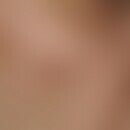Synonym(s)
DefinitionThis section has been translated automatically.
Rare localized or generalized variant of granuloma anulare with multiple, disseminated, usually non-symptomatic, rarely slightly itchy, but occasionally also slightly stinging, skin-coloured or red, also brownish, firm, flat nodules or plaques on the trunk and extremities. The face and mucous membranes remain free.
Clinically, a papular form can be distinguished from a large-area, often anularly configured plaque form.
Older lesions can also manifest exclusively as brown (sometimes atrophic) patches.
EtiopathogenesisThis section has been translated automatically.
Etiology and pathogenesis remain mostly unrecognized.
Diabetes mellitus is observed in about 10-12% of patients. Disturbances in fat metabolism (hypercholesterolemia, hypertriglyceridemia) are observed in about 45% of patients.
Allopurinol has also been described as a trigger (more recent confirmation of drug induction is missing)
You might also be interested in
ManifestationThis section has been translated automatically.
Occurs mainly in adulthood (thus later initial manifestation than in the classic anular granuloma).
LocalizationThis section has been translated automatically.
ClinicThis section has been translated automatically.
Papular exanthema with multiple, disseminated, regionally or over the entire integument distributed, solitary or confluent into larger plaques, 0.1-0.2 cm in size, blue-reddish to brownish, surface-smooth, flat papules.
The skin changes can remain asymptomatic; slight itching is possible, but also an unpleasant stinging pain.
The classic anular structure of granuloma anulare may be absent, so that the diagnosis is only made histologically. Large anular structures can be formed by the arrangement of papules around a healed center (see figure).
However, such formations are rarely seen in granuloma anulare disseminatum.
HistologyThis section has been translated automatically.
Differential diagnosisThis section has been translated automatically.
Small nodular disseminated sarcoidosis: Dense, spotty, small, papular or small-nodular, possibly lichenoid, reddish-brownish or blue-reddish lesions mainly on the face (would be completely atypical for gran.a.d.), on the extensor sides of the extremities, rarely on the trunk. Later hyperpigmentation and development of telangiectasia.
Lichen planus exanthematicus: clinically quite close analogies, the typical "shine" of the lesions is missing in the granoderm, also an infestation of the oral or genital mucosa. The histology of the L.p.d. is conclusive.
Maculo-papular (lichenoid) drug exanthema: Course with a significantly higher acuteity than in granuloma anulare disseminatum. Histology excludes the granuloma anulare disseminatum.
TherapyThis section has been translated automatically.
The therapy depends on the extent of the skin changes and ultimately also on the patient's level of suffering. In principle, a local therapeutic approach will be considered the therapy of first choice. If no satisfactory results can be achieved, local therapy should be combined with a systemic therapy.
External therapyThis section has been translated automatically.
Local therapeutic approaches:
- The first choice therapy for this form of granuloma anulare is PUVA therapy in the form of systemic PUVA or PUVA bath therapy. There are well-documented, positive experience reports on this therapeutic approach.
- Positive individual experiences have been made with dithranol in the form of minute therapy (caution: organizing effort).
- Local glucocorticoids such as 0.1% triamcinolone acetonide cream(e.g. Triamgalen, rp. 259 ) or 0.1% betamethasone lotio(e.g. Betagalen, rp. 030 ) can also be used.
- Alternatively:
- local application of a 0.1% tacrolimus ointment(e.g. Protopic®).
Internal therapyThis section has been translated automatically.
System therapeutic approaches:
- According to well-documented experience reports, therapy with fumaric acid esters(off-label use) is highly effective.
- Positive individual experiences have been reported with etanercept (2 times/week 50 mg), dupilumab, tofacitinib, baricitinib and the JAK inhibitor abrocitinib (Michels A et al. 2024).
- Alternative: hydroxychloroquine
- There are also positive casuistic reports on methotrexate, ciclosporin, retinoids and clofazimine.
Progression/forecastThis section has been translated automatically.
The course is generally protracted, often recurring for months; it is not uncommon to observe changing courses over 10 years or longer. Spontaneous healing is significantly less frequent than in the described form of the anular granuloma.
LiteratureThis section has been translated automatically.
- Choi JC et al (2003) Generalized perforating granuloma annulare in an infant. Pediatr Dermatol 20: 131-133
- Choi R et al. (2023) Janus kinase-signal transducers and activators of transcription (JAK-STAT) activation in anti-programmed death-1 (PD-1) therapy-Associated granuloma annulare: a case series. Int J Dermatol 62:e323-e325.
- Jantke ME et al. (2011) Therapy of granuloma anulare disseminatum with anthralin. Dermatol 62: 935-939
- Kain S, Stephens CJ (2003) Successfull treatment of disseminated granuloma anulare with topical tacrolimus. Br J Dermatol 149(Suppl64): 24
- Kohn S et al. (2001) Rod-shaped bodies resembling birbeck granule-like structures in endothelial cells of dermal capillaries in generalized granuloma annulare. J Dermatol 28: 5-11
- Lukács J et al. (2015) Treatment of generalized granuloma annulare - a systematic review. J Eur Acad Dermatol Venereol 29:1467-1480
- Michels A eret al. (2023) Successful treatment of therapy-resistant generalized granuloma anulare with the JAK inhibitor abrocitinib. JDDG 22: 841-843
- Min MS et al. (2020) Granuloma annulare skin profile shows activation of T-helper cell type 1, T-helper cell type 2, and Janus kinase pathways. J Am Acad Dermatol 83: 63-70.
- Schulze-Dirks A et al. (2001) Granuloma annulare disseminatum: successful therapy with fumaric acid ester. Dermatologist 52: 228-230
- Shupack J et al. (2006) Resolving granuloma annulare with etanercept. Arch Dermatol 142: 394-395
- Tursen U et al. (2002) Generalized granuloma anulare associated with Plummer's disease. J Eur Acad Dermatol Venereol 16: 419-420
- Wollina U (2008) Granuloma annulare disseminatum responding to fumaric acid esters. Dermatol Online J 14:12
Incoming links (7)
Betamethasone valerate emulsion hydrophilic 0,025/0,05 or 0,1 % (nrf 11.47.); Etanercept; Granuloma anulare classic type; Granuloma anulare generalisatum; Granulomatous interstitial Dermatitis with arthritis; Tacrolimus; Triamcinolone acetonide cream hydrophilic 0,025/0,05/0,1% (nrf 11.38.);Outgoing links (14)
Allopurinol; Betamethasone; Dithranol; Dupilumab; Etanercept; Glucorticosteroids topical; Granuloma anulare classic type; Lichen planus exanthematicus; Off-label use; Puva bath therapy; ... Show allDisclaimer
Please ask your physician for a reliable diagnosis. This website is only meant as a reference.



























